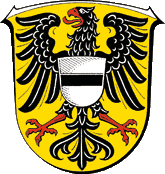
Gelnhausen lies to the south of the Vogelsberg Hills. Beneath the red sandstone, there is a layer of shale containing many water-bearing channels which come to the surface where the shale is exposed on the slopes.
Fresh water is thus plentifully available – an essential requirement for any settlement. The good supply of water was surely a factor in Emperor Frederick I “Barbarossa’s” decision to establish a town and palatinate here.
Many homes had their own wells. 68 wells were counted in a survey, but occasionally further ones are discovered during building work, most recently in the Breydenbach cellar on Untermarkt, the Lower Market Place.
The public wells in and around the town were supervised by officially nominated citizens. The pollution of wells was a criminal offence. For example, in the regulations of a city in Saxony dated 1569, a fine is imposed for washing in public wells or contaminating them in any other way.

Foundation on Obermarkt
It is a modern architectural decoration from 2002 designed by the Gelnhausen artist Achim Gogler.

Brunnen des Franziskaner-Klosters
The well of the Franciscan Monastery

The well of the Teutonic Order
The draw well of the Teutonic Order still exists in their former trading post in Holzgasse

Steinbrunnen
The Steinbrunnen is at the top of the lane “Am Steinbrunnen”, beneath the Halbmond or Half Moon Tower

Overflow from the Steinbrunnen
Water flows from two lions’ heads

The Lambertusbrunnen
The Lambertusbrunnen

A typical household well

Holzborn
The well-house of the Holzborn is located outside the town wall on the hillside north of the town

Friesenborn
The well-house of the Friesenborn is to be found to the east of the town.

Brunnen des Klosters Himmelau
The well-house is one of the few remnants of the convent buildings

Digitaler Stadtrundgang
Barbarossastadt Gelnhausen
loading ...
A satelles.de service:
find out - experience - discover




